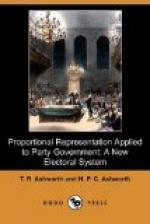The Hare system is sometimes advocated for clubs on account of its supposed just principle. Any live club which adopts it runs the risk of disruption. It merely encourages the formation of cliques and sections; any slight split would be accentuated and rendered permanent.
+The Limited Vote.+—The injustice of the Block Vote led to the introduction of the Limited Vote, which allows the minority some share of the representation. We have seen that the Block Vote forces each party to try to return all the representation, and of course one party only can succeed. But if neither party be forced to try to return more than it is entitled to each party will get its correct share of representation, providing both parties are equally organized. This leads to the Limited Vote, in which each elector has a number of votes somewhat less than the number of seats.
The Limited Vote was used in England for a number of three-seat electorates, which were created by the Reform Bill of 1867, each elector being allowed to vote for two candidates only. By this means the majority would usually return two candidates and the minority one. Thus the Limited Vote has the same advantage as the Block Vote and the single electorate system, that it tends to confine representation to the two main parties, but it creates an artificial proportion of representation between them. Moreover, it renders strict party organization even more necessary, since each party must arrange to use its voting resources to the best advantage. Consider the three-seat electorate, for instance. The minority will, if it is wise, nominate two candidates only; and the majority may nominate either two or three. But if the majority does divide its votes among three candidates it runs the risk of securing one only. It can do so safely when two conditions are fulfilled: first, it must be sure of polling more than three-fifths of the votes; and, second, it must arrange to distribute all its votes equally among the three candidates. It is not surprising, therefore, to find that the Limited Vote was responsible for introducing “machine” tactics into England. In Birmingham, when Mr. Joseph Chamberlain organized the Liberals and succeeded in carrying all three seats, the electors in each ward were directed how to vote so that as few votes as possible might be wasted. These three-cornered constituencies were abolished by the Redistribution Act of 1884; and Sir John Lubbock, reviewing the experiment, declared—“On the whole, it cannot be denied that under the Limited Vote the views of the electors have been fairly represented.”




